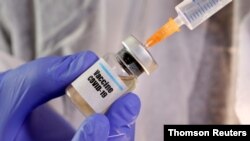The economy will not fully recover until a vaccine against COVID-19 is available, experts say.
But once a vaccine is available, polls show one-quarter to one-third of Americans don't plan to get it.
That means bringing the pandemic to an end and getting people back to work is not just a medical science challenge. It’s a social science challenge, too.
And while billions of dollars are going into solving the medical issues, none of it is earmarked to address the social issues, according to a new report.
"You can't just have a clinically successful vaccine. You have to have a socially acceptable vaccine," said co-author Monica Schoch-Spana, a cultural anthropologist and senior scholar at the Johns Hopkins Center for Health Security.
Scientists are moving at unprecedented speed to develop a safe and effective vaccine against the coronavirus that causes COVID-19. But "there wasn't enough forethought about the importance of understanding the human factors," Schoch-Spana said.
So she and 22 co-authors, including prominent epidemiologists, vaccinologists and social scientists, put together the report to show where to fill the gaps.
"In light of the high stakes, and the charged social environment, there have to be extra measures taken," she said.
Politically charged
Vaccine opponents have been "very, very effective at connecting their anti-vaccine movement with some of the political issues" around COVID-19, protesting against lockdowns and refusing to wear masks, noted L.J. Tan, co-chair of the National Adult and Influenza Immunization Summit, a public-private vaccine advocacy coalition.
Some of the messaging from the Trump administration has not helped build confidence, either, Schoch-Spana said.
For example, naming the vaccine program Operation Warp Speed gives the impression that swiftness is more important than safety.
The administration has undermined medical experts by continuing to insist that the drug hydroxychloroquine is effective against COVID-19 when gold-standard studies have found it is not. Suggesting ultraviolet light or bleach as treatments hasn't helped, either, Schoch-Spana's report said.
One poll has found that an endorsement from President Donald Trump would make 36 percent of respondents less likely to get a vaccine, compared with 14 percent who would be more likely.
Barbershop epidemiology
Communities of color who are disproportionately affected by COVID-19 are also the most hesitant to get vaccinated. Polls have found from 25 percent to 44 percent of African Americans say they would not get a vaccine.
It's partly a result of unethical medical experiments on African Americans in the 20th century, "a legacy of malfeasance and malpractice feeding mistrust today," Schoch-Spana said, in addition to present-day discrimination they face from the health system.
Health officials are getting past the mistrust by connecting with local nonprofits, churches, community groups, even hair salons and barbershops, which can be champions for vaccination.
"Those places are where people congregate and share information and, by the way, make health decisions," Schoch-Spana said.
With influenza season coming up, health officials are aiming to ramp up those and other channels. The goal, as Tan puts it, is to take flu out of the equation because seasonal flu on top of a second wave of COVID-19 would push the health system to the brink.
"We've got existing infrastructure and existing systems that we know work, but they're not working well," he added. Communities of color get flu vaccines at lower rates than other groups. If officials can improve those systems, they can leverage them for COIVD-19 as well, Tan said.
Not persuasive
Connecting with trusted community members is likely to be more effective than education campaigns aimed at increasing confidence in vaccines, or appealing to people's sense of altruism, according to University of North Carolina at Chapel Hill health behavior professor Noel Brewer.
"The research is fairly clear that persuasion approaches are not all that effective for vaccination," he said. Brewer co-authored a separate report on vaccine hesitancy.
"What is effective in increasing vaccination is establishing systems that are easy to use and reach many people," he added.
That could include delivering vaccines in unusual places, including churches, community centers and mobile clinics, Schoch-Spana said.
"It isn't just enough to go to the convenient pharmacies in the community," she noted. "It's also about going to places that people can access readily and feel comfortable, safe and familiar to them."
When a vaccine arrives, there will not be enough for everyone, at least initially.
"So there have to be decisions made about who gets to stand in line first for that limited set of doses," Schoch-Spana said. "That's not just a technical question. That's also a question that's informed by social values."
In the current politically charged environment, those decisions need to be made with transparency and accountability, she said. "The systems have to be built so that they are fair, and people need to recognize that they are fair."
There could be additional upsides to getting it right, she added.
"If we do this vaccination program well, we will not only protect people's health,” Schoch-Spana said. “We will regain people's trust in institutions like government and public health and vaccine science."








